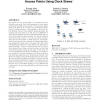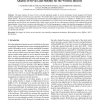INFOCOM
2011
IEEE
13 years 9 months ago
2011
IEEE
—Due to the rapid growth of real-time applications and the ubiquity of IEEE 802.11 MAC as a layer-2 protocol for wireless local area networks (WLANs), it is of increasing interes...
TMC
2010
14 years 4 months ago
2010
We explore the use of clock skew of a wireless local area network access point (AP) as its fingerprint to detect unauthorized APs quickly and accurately. The main goal behind usi...
CORR
2007
Springer
14 years 5 months ago
2007
Springer
The IEEE 802.11e standard revises the Medium Access Control (MAC) layer of the former IEEE 802.11 standard for Quality-of-Service (QoS) provision in the Wireless Local Area Networ...
IJWMC
2007
14 years 5 months ago
2007
: The Third Generation (3G) cellular networks provide ubiquitous connectivity but low data rates, whereas Wireless Local Area Networks (WLANs) can offer much higher data rates but ...
JNW
2008
14 years 6 months ago
2008
Next-Generation Wireless Networks (NGWNs) present an all-IP-based architecture integrating existing cellular networks with Wireless Local Area Networks (WLANs), Wireless Metropolit...
COMCOM
2008
14 years 6 months ago
2008
Wireless Mesh Networks (WMNs) are one of the few commonly implemented types of mobile ad-hoc networks (MANETs); several companies offer WMNs for broadband Internet access and for ...
WMI
2001
14 years 7 months ago
2001
Our paper explores the issue of how to provide appropriate quality of service mechanisms closely integrated with flexible mobility management in wireless local area networks. We co...
AUSFORENSICS
2003
14 years 7 months ago
2003
Many organisations and individuals are installing wireless local area networks (WLANs), which are based on the IEEE 802.11b standard. Insecurely configured WLANs present a threat ...
AICT
2005
IEEE
14 years 8 months ago
2005
IEEE
Automatic repeat request (ARQ) schemes are effective to recover non-real-time data corrupted by channel errors, but their use with real-time traffic is seldom considered because p...
FTDCS
2004
IEEE
14 years 9 months ago
2004
IEEE
In wireless local area networks (WLANs), mobility support is essential for providing seamless services. The current Mobile IP standard suffers several problems, especially for acc...






